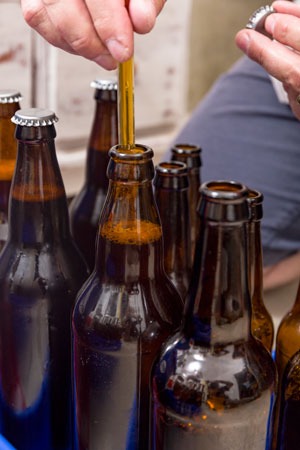Bottle-Condition Like A Champ
TroubleShooting
Robert Aveling — Slimminge, Sweden asks,
I recently enjoyed a champagne-style bottle of bottle-conditioned Affligem Blonde, and I noticed this bottle was without residue from the second fermenting. I assume a second fermentation with fresh yeast and sugar is how they manage to create the higher carbonating pressure these beers have. But how do they get the beer in the bottle without creating any residue? Does This mean that the second fermentation occurs somewhere other than in the bottle? I am now brewing a clone. I planned to rack from the secondary fermenter to a keg, and add fresh yeast and sugar. Then use a pressure gauge/spunding valve to regulate the carbonation before bottling from the keg. I just wonder if this method could work or do you have any other suggestions? I’m also bottling some normal bottles with the yeast and sugar to check any differences. Looking forward to hearing your comments.
I am not sure how Affligem goes about bottling their beers, but your question generally applies to bottle-conditioned beers, especially those that have very little yeast sediment in the bottle. There are a few unrelated topics that address your question, so I will cover this topic in two short vignettes.
Producing clear, bottle-conditioned brews
This may seem like an oxymoron as yeast is required to bottle condition, but it is relatively easy to produce clear, bottle-conditioned beer without having an excess amount of sediment in the bottom of your bottles. The first step is to forget about what is going to happen in bottle, and to focus on producing clear beer. This means considering all of the clear-beer tools and methods available to the homebrewer; thorough mashing using the appropriate temperature rests to match your grist bill, vigorous wort boil, kettle finings, flocculent yeast strain for primary fermentation, complete fermentation (no residual fermentable extract is wanted), finings to remove yeast and haze proteins, cold aging, and perhaps filtration. The objective is to produce clear beer.

Once you have produced clear beer, you now need to prepare for bottle-conditioning. This is a separate process and is independent from what has been done up to this point. The three variables that require definition at this point are: 1) beer volume, 2) carbon dioxide content, and 3) fermentable extract remaining in your beer (should be zero to make this process easiest and most consistent). This information is used to calculate the amount of priming sugar required. You also need a small amount of yeast for the process; 500,000 to 1,500,000 cells/mL is all that is needed to condition most beers (high-alcohol and/or low-pH beers may require more yeast). I suggest using a special strain intended for this purpose, such as Fermentis SafAle F-2 or Lallemand CBC-1 that are flavor-neutral, robust, and tend to stick to the bottle surface upon settling. Assuming that you have 4.75 gal. (18 L) of beer with 4.4 g/L of residual carbon dioxide, and you want to have 8 g/L after conditioning is complete, you need to add 133 grams of priming sugar and about 1 gram of yeast before bottling.
Minimize oxygen in your bottles
Proper bottling is critical to excellent beer. Brewers often jest that the best beer from the brewery is messed up by the packaging department. Throwing stones is never a great idea when you live in a glass house, but there is truth to this parable. Seemingly minor errors during packaging can cause major problems with beer quality. Purging empty bottles with carbon dioxide and capping beer on foam are the two most important steps a brewer can take to minimize beer degradation in the bottle. This is as true for bottle-conditioned beers as it is of beers that are fully carbonated and devoid of yeast when bottled. Capping on foam requires sufficient carbonation for the beer being bottled to actually foam. A nice carbonation level at the time of bottling is somewhere between 2–2.5 volumes or 4–5 g/L; enough carbonation to make foaming before capping easy, but not so much to make for difficult filling.
Purging empty bottles with carbon dioxide and capping beer on foam are the two most important steps a brewer can take to minimize beer degradation in the bottle.
This discussion may seem out of place in an answer about bottle conditioning. After all, bottle-conditioning replaces carbonation prior to packaging, right? While it is true that “flat beer” can be completely carbonated using bottle-conditioning, this method does not prevent beer oxidation because the damage caused by oxygen usually occurs before the yeast in the beer has a chance to help. This is especially true when very low cell counts are used for conditioning. So why should brewers bottle-condition if they are going to bottle beer using methods that also work for fully carbonated beer? Simple; highly carbonated beer, like Affligem Blonde, is nearly impossible to bottle. The practical carbonation limit to bottling carbonated beer is about 3 volumes or 6 g/L, because the fill tube must be removed from the bottle and anything other than extremely slow bottle de-pressurization results in gushing bottles. The method you describe is a perfect fit for this process, and you can certainly jump start the process in your keg and bottle when your carbonation is high enough to cap
on foam.
In short, bottle-conditioning is a specialist’s tool allowing the brewer to easily and consistently produce highly-carbonated, Champagne-like bottles of exquisite beer. And if you begin with very clear, even filtered, beer, the yeast in the bottle can go almost completely unnoticed.
